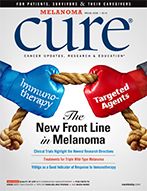Publication
Article
CURE
QOL Similar With Checkpoint Combo Versus Single-Agent Immunotherapy in Melanoma
Author(s):
Patients with melanoma who were treated with a combination of Opdivo and Yervoy showed no significant changes in their quality of life when compared to those who were treated with either agent alone.
With immunotherapy gaining importance as a therapy for melanoma, and with excitement gathering about the potential added benefits that can come with combinations of these medications, there is a lot of interest in the kinds of side effects that will emerge with immunotherapy pairs. Encouraging recent data showed few differences in quality of life (QOL), global health and symptom burden between patients with melanoma who were treated with Opdivo (nivolumab) plus Yervoy (ipilimumab) or either agent alone. The results were from an analysis of patient-reported outcomes from the phase 3 CheckMate-067 trial.
After one year of follow-up, patients in the Opdivo plus Yervoy arm of the trial experienced no clinically meaningful change in health-related QOL — even though they showed significant improvements in survival. Additionally, patients treated with Opdivo alone or Yervoy alone showed no significant changes in QOL compared to baseline, said Dirk Schadendorf during a presentation at the 2015 Society for Melanoma Research Congress.
“The nivolumab plus ipilimumab treatment arm had the highest frequency of adverse events, but these adverse events did not seem to affect patient-reported QOL outcomes,” said Schadendorf, director of the Department of Dermatology at the West German Cancer Center at the University Hospital in Essen, Germany.
In the CheckMate-067 study, 945 patients with advanced melanoma were treated with Opdivo alone, Yervoy alone, or a combination of the two. Patients in the combination arm showed improved progression-free survival (PFS). The median PFS with the combination was 11.5 versus 6.9 months with Opdivo alone and 2.9 months with Yervoy alone.
Adverse events (AEs) were more frequent with the combination treatment, with 55 percent of patients in that arm experiencing having grade 3/4 (serious to severe) AEs versus 16.3 percent with Opdivo alone and 27.3 percent with Yervoy. Additionally, over 29 percent of patients in the combination arm experienced a treatment-related AE leading to treatment discontinuation.
Despite the higher incidence, AEs in the study were short-lived. The median time for resolution of grade 3/4 AEs was 1.7 to 4.2 weeks, Schadendorf said.
To assess patient-reported QOL, researchers used a questionnaire about health status, and another form in which patients rated their health status on a scale from 0 to 100 and also specifically rated five dimensions of their health: self-care, mobility, usual activities, pain/discomfort and anxiety/depression.
Schadendorf noted that patient characteristics were well balanced among the treatment arms at baseline, suggesting that it is unlikely that pre-existing patient health outcomes affected the results.
Reductions were seen in questionnaire scores across all arms; however, these findings were not deemed clinically meaningful because they did not represent a decrease in well-being of 10 ponts or more. At week five, there was reduction of 2.7, 4.3, and 3.1 points for Opdivo alone, the combination and Yervoy alone, respectively. Scores returned to baseline levels by week 25 in the Opdivo-alone arm and by week 31 in the combination and Yervoy-alone arms.
The ratings-scale scores improved at week 13 with Opdivo alone, which persisted throughout the trial. However, in the Yervoy-containing arms, these scores initially worsened before returning to baseline by week 13 for the combination and by week 19 for Yervoy alone. Scores on the five specific dimensions of health were stable for the Opdivo-containing arms and worsened with Yervoy until week 23.
“Even among patients who suffered severe toxicities such as colitis, treatment did not appear to have a significant effect on quality of life,” Schadendorf said. “Do the results in this study indicate that patients don’t care about toxicity when they receive a large survival benefit, or is it that QOL wasn’t affected because the toxicities were short-lived?”
One shortcoming of the analysis was that patients who discontinued treatment were not included in QOL assessment, Schadendorf said. To account for this, data are being analyzed that include patients who progressed or discontinued. Additionally, patients will continue to be followed in the study to assess whether the tumor control benefits observed in CheckMate-067 will affect long-term patient QOL outcomes, he said.
“One possible explanation for our findings in this study could be that the tools we have now — utilized in our analysis — are not very useful for assessing QoL in patients treated with newer immunotherapy agents,” Schadendorf said. “Yet these are the only instruments we have that are validated, and it could take years to obtain new and better validated tools.”





